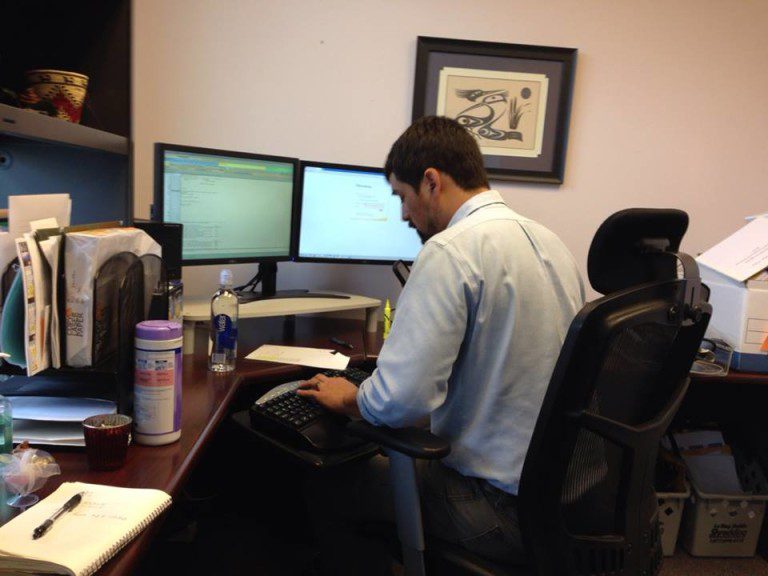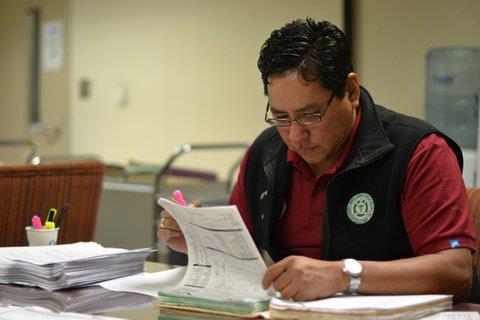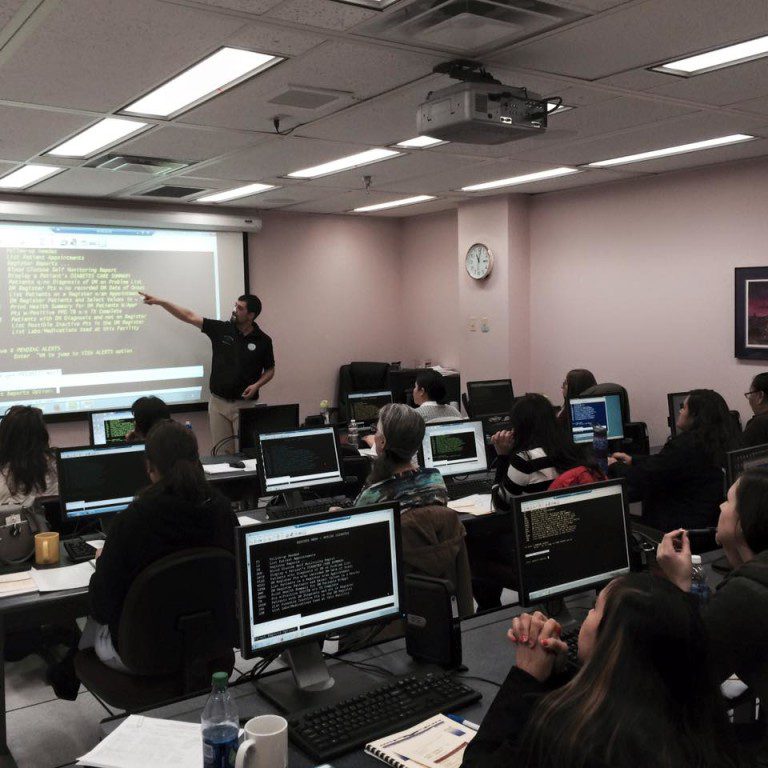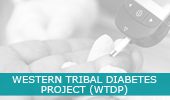The mission of the Western Tribal Diabetes Project (WTDP) is to empower tribal communities to utilize diabetes data at the local level to track the Indian Health Service Standards of Care for Patients with Type 2 Diabetes, insure patients receive timely care, improve case management, identify gaps in care, and better address program planning.
The Western Tribal Diabetes Project serves the 43 federally recognized tribes in Idaho, Oregon, and Washington. The WTDP National component serves diabetes programs outside of the Portland Area.
Diabetes Management System training
The WTDP offers free, hands-on training for using the Diabetes Management System package of the Resource and Patient Management System. Topics include building and maintaining diabetes and pre-diabetes registers, editing patient information, and running register and quality assurance reports. Additional topics include using QMAN for custom searches to meet needs that commonly arise for diabetes programs, creating panels of patients in iCare, and performing the annual IHS Diabetes Audit with WebAudit.
Upcoming Trainings for 2022:
- March 1-2, 2022
- June 14-15, 2022
- September 27-28, 2022
- December 6-7, 2022
WTDP also hosts programs from across the nation for Native Fitness XIV, at the Nike World Headquarters in Beaverton, OR, September 6-7, 2018.

“To build a sustainable infrastructure for monitoring, tracking, and reporting diabetes data at the local level.”
The goal of Western Tribal Diabetes Project (WTDP) is to provide technical assistance to Northwest Tribes to develop a system for sustained data collection, reporting, and utilization. The objectives of WTDP are designed to assist the Tribes:
- Build a foundation to provide complete and accurate information about patients
with diabetes - Estimate the burden of disease and impact of diabetes by using an electronic
diabetes register - Improve health outcomes by using an electronic diabetes register to make informed decisions about clinical diabetes care
- Prevent diabetes in high-risk individuals.
WTDP has developed several tools to guide diabetes programs through a step-by-step approach for data improvement and health promotion. To learn more about WTDP, including our step-by-step approach and tools, please visit our Project Information Page.

In 2002, 15.3% of all adult American Indian and Alaska Native (AI/AN) IHS users had diabetes, more than twice the level in U.S. adults overall (7.3%). These prevalence figures represented a dramatic increase, both for AI/AN IHS users – where the prevalence of diabetes was 11.5% in 1994 – and for the US general population – where the prevalence of diabetes was 4.8% in 1994.4 The number of AI/ANs younger than 35 who were diagnosed by the IHS more than doubled between 1994 and 2004, from 6,001 patients to 12,313. Overall, the prevalence of diagnosed diabetes among AI/ANs under 35 was about 1.7% in 2004.
Increases in the level of diagnosed diabetes may be partly due to enhanced screening through the Special Diabetes Program for Indians (SDPI), implemented in 1997. While the level of diagnosed diabetes has been on the rise, intermediate outcomes have improved for IHS diabetes patients since the start of the SDPI. Recent analysis of the Annual Diabetes Care and Outcomes Audit showed improvements in mean Hemoglobin A1c, blood pressure, and cholesterol levels.
In the Northwest, about 11.2% of adult tribal enrollees said they had been diagnosed with diabetes (not including gestational diabetes) in a 2001 survey. Diabetes increased with age, to almost a third (31.5%) of AI/ANs 60 years and older reporting a diagnosis. More than half of tribal members had been tested for diabetes in the previous five years (57.1%).
The Diabetes Management System (DMS) can be a rich source of information for tribes that use the Resource and Patient Management System (RPMS). Check with the local diabetes program or RPMS site manager to find out if the DMS is in use.
- National Diabetes Information Clearinghouse (NDIC). Your Guide to Diabetes: Type 1 and Type 2. http://www.diabetes.niddk.nih.gov/dm/pubs/type1and2/index.htm.
- The Unofficial IHS Diabetes Care & Outcomes Audit Support Site. IHS Standards of Care for Patients with Type 2 Diabetes. http://www.dmaudit.com/socfork.htm.
- Indian Health Service Division of Diabetes Treatment and Prevention. Clinical Guidelines for Adults with Prediabetes and/or the Metabolic Syndrome. http://www.ihs.gov/MedicalPrograms/Diabetes/index.asp.
- Diabetes prevalence among American Indians and Alaska Natives and the overall population—United States, 1994-2002. MMWR Morb Mortal Wkly Rep. Aug 1 2003;52(30):702-704. http://www.cdc.gov/mmwr/preview/mmwrhtml/mm5230a3.htm.
- Diagnosed diabetes among American Indians and Alaska Natives aged <35 years–United States, 1994-2004. MMWR Morb Mortal Wkly Rep. Nov 10 2006;55(44):1201-1203. http://www.cdc.gov/mmwr/preview/mmwrhtml/mm5544a4.htm
- Wilson C, Gilliland S, Cullen T, et al. Diabetes outcomes in the Indian health system during the era of the Special Diabetes Program for Indians and the Government Performance and Results Act. Am J Public Health. Sep 2005;95(9):1518-1522.
- Romero F, Hasty F, Rose R, et al. Northwest Tribal Behavioral Risk Factor Surveillance System (BRFSS) Project, Aggregate Final Report. Portland, OR: Northwest Portland Area Indian Health Board; 2003. Full report available for download from this website under “Resources – Reports”.
The WTDP consists of two divisions: Northwest and National. WTDP delivers its services through support from our Portland offices and site visits to participating tribes. During the site visits WTDP staff provide hands-on training and support. Most sites receive at least two site visits.
Working with participating tribes, WTDP uses a step-by-step approach for diabetes data improvement.
Diabetes (also called diabetes mellitus) is a chronic disease usually characterized by very high levels of blood glucose (often called blood sugar). There are two major types of diabetes, now called type 1 and type 2. Although the two forms are different in many ways, the end result of both is high blood sugar and the long-term complications that result.
Over time, diabetes can damage nearly every tissue in the body and result in disastrous complications, including heart attacks, stroke, blindness, kidney failure, and amputations of toes, feet, or legs. Because of the risk of these complications, patients who have diabetes should have regular check-ups. The IHS Standards of Care for Patients with Type 2 Diabetes describe recommended checks in detail.
Prediabetes is a related condition in which blood sugar levels are high, but not as high as in diabetes. In 2006, the IHS released standards of care for prediabetes, including screening guidelines. Another related condition, gestational diabetes, sometimes develops in women during pregnancy. Although gestational diabetes usually goes away after the baby is born, a woman who has had it has a higher chance of developing type 2 diabetes later in life. With modest weight loss and regular physical activity, people can delay or prevent the onset of diabetes.

Tribal site visits and centralized hands-on computer trainings are at the core of the WTDP model. This model assists WTDP in tailoring technical assistance to address specific tribal program needs to improve diabetes data.
- WTDP will assist tribes in establishing an active, accurate diabetes register. WTDP works with the diabetes team to develop a work plan, conduct medical chart reviews, and assist in program planning.
- WTDP will assist the diabetes team in using the diabetes register to make informed decisions regarding clinical care and case management. WTDP will assist the diabetes team in using the register to track and prevent complications in patients with diabetes, identify data gaps in the register, and improve the care of patients with diabetes.
- WTDP has developed a number of tools for tribal programs that aid in assessing the data capture and utilization capabilities of diabetes programs. Tribal programs can use these tools to self-assess and determine what areas they need to focus on in order to arrive at using diabetes data for prevention activities.
- WTDP offers several tools that help tribal programs in screening patients for diabetes, and tracking patients who are at-risk for developing type 2 diabetes using the electronic register. WTDP assists tribal programs in using patient data to develop prevention strategies.
- At the request of the Northwest Tribes, the WTDP also conducts conferences and workshops pertaining to diabetes and diabetes-related information.
Along with our step-by-step approach, WTDP has developed several tools to be used throughout the data improvement process. These tools include:
- Diabetes Management System Short Cut and Reference Manual w/Table of Contents
- Diabetes Screening Toolkit w/Table of Contents
- 2017 Health Status Report blank
- 2017 Health Status Report Demo
For a brochure of our tools please click here.
Portland Area Health Status Report
- 2018 Portland Area Health Status Report (PDF)
- 2017 Portland Area Health Status Report (PDF)
- 2016 Portland Area Health Status Report (PDF)
- 2015 Portland Area Health Status Report (PDF)
- 2014 Portland Area Health Status Report (PDF)
- 2013 Portland Area Health Status Report (PDF)
- 2012 Portland Area Health Status Report (PDF)
- 2011 Portland Area Health Status Report (PDF)
- 2010 Portland Area Health Status Report (PDF)
- 2009 Portland Area Health Status Report (PDF)
Northwest Regional Diabetes Conference 2015 Presentations

- American Association of Diabetes Educators
- American College of Endocrinology
- American Diabetes Association (or call 1-888-DIABETES)
- American Dietetic Association
- Canadian Diabetes Association
- CDC’s Diabetes Public Health Resource
- Channing L. Bete, Inc. (Diabetes educational materials)
- Children with Diabetes (family information and resources)
- Diabetes Digest
- Diabetes Exercise and Sports Association
- Diabetic Gourmet Magazine
- Diabetes In Control
- Diabetes Prevention Program
- Doctor’s Guide Personal Edition (medical news and information)
- Footcare Kit for Diabetes – National Diabetes Education Program
- International Consensus on the Diabetic Foot
- International Diabetes Center, Publishing Office
- Indian Health Service National Diabetes Program
- Joslin Diabetes Center
- Juvenile Diabetes Research Foundation International
- Krames Communications (Diabetes educational materials)
- NASCO Teaching Aids
- National Diabetes Education Program
- National Diabetes Information Clearinghouse
- Diabetes in American Indians and Alaska Natives
- National Diabetes Prevention Center
- National Institute of Diabetes and Digestive and Kidney Diseases
- National Eye Health Education Porgram (National Eye Institute)
- National Guideline Clearinghouse
- Native American Diabetes Project: “Strong in Body and Spirit”
- Native Health Research Database
- Nutrition Counseling Education Services (NCES)
- Office of Minority Health Resource Center
- Park Nicollet HealthSource (diabetes educational materials)
- PubMed
- QuickLog (free diabetes logbook for your computer)
- Taking on Diabetes
- Women’s Health Matters: Diabetes Health Centre
-
DMS Training
The Western Tribal Diabetes Project conducts four Diabetes Management System trainings each year, in March, June, September, and December. Diabetes programs are invited to attend the training on the DMS in RPMS and EHR. The hands-on sessions also cover related packages, such as iCare and QMAN.

-
Native Fitness
In addition, WTDP has hosted programs from around the nation for Native Fitness, an innovative and popular training for tribal fitness programs. Sessions include ideas for working with all age groups and varying fitness levels, getting programs started, and tracking program outcomes. Native trainers demonstrate activities using traditional games and movements, recognizing the importance of cultural competency and a holistic approach in implementing tribal exercise programs.
-
Risky Business
WTDP partners with Northwest Portland Area Indian Health Board projects to provide a combined one-day training on diabetes, cancer, sexually transmitted diseases, maternal child health, and tobacco prevention.

Western Tribal Diabetes Project













